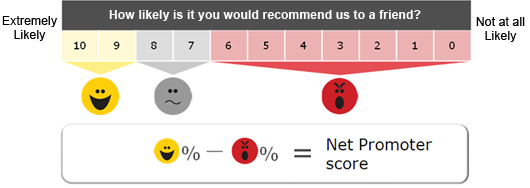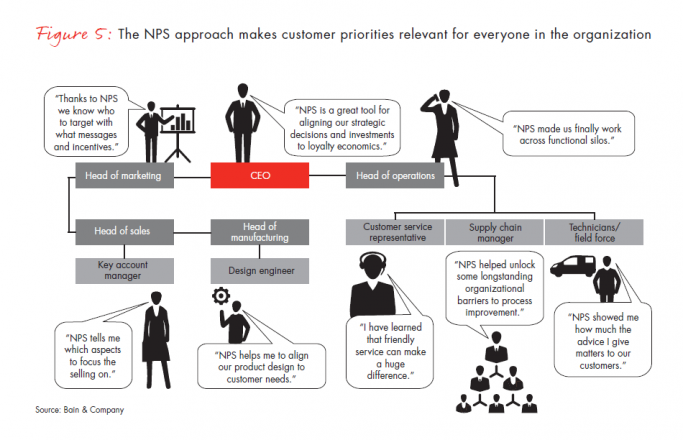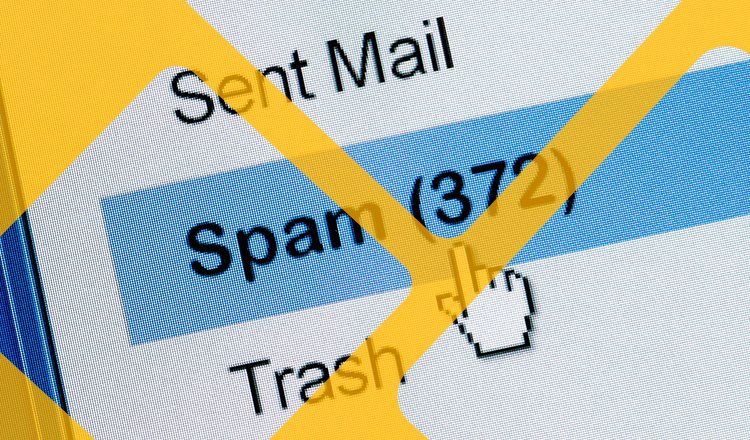“Greatness is achieved when customers say we’re great.” Lanham Napier, CEO, Rackspace
Every company wants to be great. Great products, great sales, and great relationships with loyal customers. However, according to Bain & Company research, 68% of B2B respondents say customers are growing less loyal. If only there was an easy way to unlock key insights into customer loyalty and make customers stay with your brand. There is, and it’s called the Net Promoter Score (NPS). If you haven’t been using NPS to track your B2B customer satisfaction, it’s time to start. Here’s your introduction to the NPS t and how to use it to measure customer satisfaction trends and ultimately improve your bottom line.
What Is Net Promoter Score and How is it Calculated?
The Net Promoter Score is a great addition to the surveys you should be continually running to capture feedback and gauge customer satisfaction with your brand. NPS is a customer loyalty metric that measures willingness to recommend your products or services to others. It is calculated based on customer responses to a single, straightforward question: How likely are you to recommend our company/product/service to a friend or colleague? The question is answered on a scale from 0 to 10. The overall results are then transformed into a business score that ranges from -100 to +100. The Net Promoter Score calculation is simple; here’s how to do it.
First, break the responses d into three groups based on the score they provided:
Promoters are customers that ranked you 9 or 10. These loyal enthusiasts fuel viral growth through word-of-mouth advertising on and offline.
Detractors are customers that marked 0 through 6. These are dissatisfied and probably churning customers.
Passives answer 7 or 8. These neutral customers are neither enthusiastic nor unenthusiastic about your brand.
To calculate your NPS:
(Number of Promoters – Number of Detractors) ÷ (Number of Respondents) x 100
Leave passives out of the NPS calculation. They exert a negligible influence on your brand’s reputation.

So, once you’ve calculated your score, how do you evaluate it? Your target score depends on your industry.
Reading the B2B Net Promoter Score
There’s no magic number for all B2B industries. However, the average NPS for B2B typically ranges from 25 to 33. Want to know where you stand for your industry? Take a look at these NPS industry averages.

As you can see, B2B manufacturers of all stripes and large enterprise usually hit NPS between 20 and 30 scores. Energy and chemical companies, commodity suppliers and professional services companies achieve NPS below 20.
If you use the NPS scale from -100 to +100, consider the score above 0 to be good, over 35 to be excellent, and above 50 as world class. If your NPS is below zero, you must urgently start resolving customer loyalty and satisfaction issues. NPS scores are most effectively evaluated as trend indicators. They are not a one-time snapshot. On-going NPS analysis will tell you if your score trending up or down. The direction of your trend is an early-warning indicator of customer satisfaction and loyalty. Like the proverbial canary in the coal mine, a downward NPS trend can detect a problem before you are even aware it exists.
Benefits of NPS for B2B
37% of B2B brands measure NPS along with other customer marketing activities. NPS for B2B SaaS users has many benefits. Here are just a few.
NPS surveys are easy to launch and they drive high response rate.
NPS surveys are easy to run. Because they are quick to answer, they garner higher response rates than traditional surveys. The relationships between B2B sellers and buyers are long-lasting and trusted, this also results in high NPS survey response rates. In fact, the target NPS response rate for B2B companies is 50% higher than for consumer businesses. On the whole, as a B2B seller, you can expect to earn response rate of 60% or above. This means you should have enough quality data to be used for accurate NPS calculation.
NPS helps better identify target segments.
NPS analysis let you better understand what your target audience expects from your products and assess whether you properly meet these expectations. NPS instantly identifies unsatisfied customers while there is still time to save the relationship. You can combine the NPS calculation results with user demographics and engagement data to obtain deep insights into your target audience and identify the root causes for buyers happiness or frustration.
NPS surveys generate actionable customer feedback.
Because relations between B2B buyers and sellers are strong and continue over time, customers tend to provide qualitative and meaningful feedback based on their overall brand perception and experience. And because B2B sellers have a fewer number of customers than B2C, NPS survey responses can be acted upon quickly. As the result, companies can identify customer pain points and make necessary changes required to address customer satisfaction issues and improve customer engagement.
NPS helps improve overall customer loyalty initiatives.
Once you discover your promoters, you can then compare their customer journey with detractors. Take the differences you spot and rethink your customer loyalty programs. You can’t expect customers to be loyal to you if you are not loyal to them first., Incentivize promoters with referral offers in exchange for testimonials that generate appeal to new customers.
Insights gained from NPS feedback helps innovate operations across the company.
NPS feedback can be received almost in real time. This gives it global value on an enterprise level. All roles and functions across the selling company must understand what steps they should take to make the company great and produce a stellar customer experience.

So, measuring your NPS has great potential for producing actionable insights. But only if it is done properly. Like conducting any survey, NPS surveys have best practices.
Best Practices for Conducting NPS Surveys
To generate the best value from NPS for B2B, make sure you’re surveying the proper customer segments and soliciting feedback at the appropriate time. Before you ask customers to rate their willingness to recommend your company, consider the following:
Time and frequency
Although NPS measuring is an ongoing process, don’t run more than two NPS surveys per year. Deliver your initial survey shortly after a customer orders for the first time and begins their relationship with your business. Depending on your product or service, this could be the first 7-30 days after the initial delivery. This will help you understand if customer expectations were met. If you update products and services regularly, wait until the next 60-90 days to send out the second NPS survey. If you don’t upgrade your offerings too frequently, wait another 3-6 months before sending out the next survey. In both cases, you’ll get insights into how customer satisfaction changed.
Are you targeting the right stakeholders?
Behind each B2B buyer, there’s an entire group of decision-makers, employees responsible for contract implementation, and product end-users. Sending out your NPS survey to all, without giving thought to their function within the organization is a sure-fire way to get poor response rates and low-quality feedback. Instead, address the right stakeholders.
Got customer data? Put it into your CRM.
Because NPS data is all about customer feedback, experience, and retention, it’s natural home is your CRM, next to other sets of valuable customer information. If your CRM comes with a robust segmentation feature, be sure to group your customer base into segments to craft more targeted and thus more efficient NPS campaigns. This is particularly helpful in reaching the relevant stakeholders with the survey.
Results captured? Act on them!
The main purpose of NPS surveys is not to count scores. It’s to acquire and measure feedback and then act upon it. Look beneath NPS, figure out the reason for the scores you’ve been given, and make changes. Your goal is to convert detractors to passives, turn passives to promoters, and let promoters grow to become brand advocates. Don’t forget, NPS not only uncovers stumbling blocks and pain points, but it also captures trends that drive customer satisfaction.
Are you using NPS? How have you improved your customer lifetime value and customer experience based on the NPS? Let us know in the comments below.



